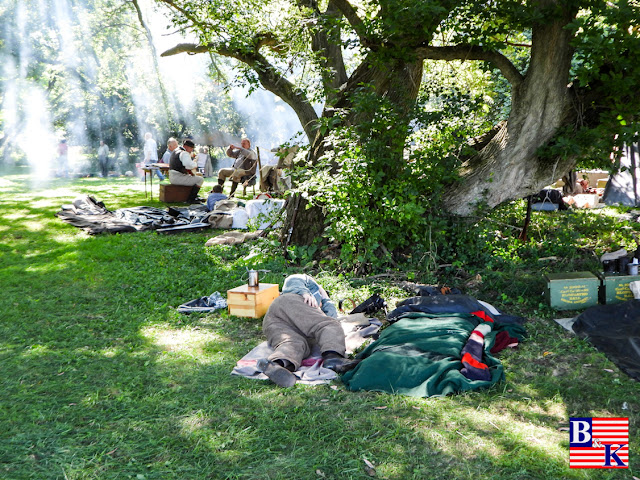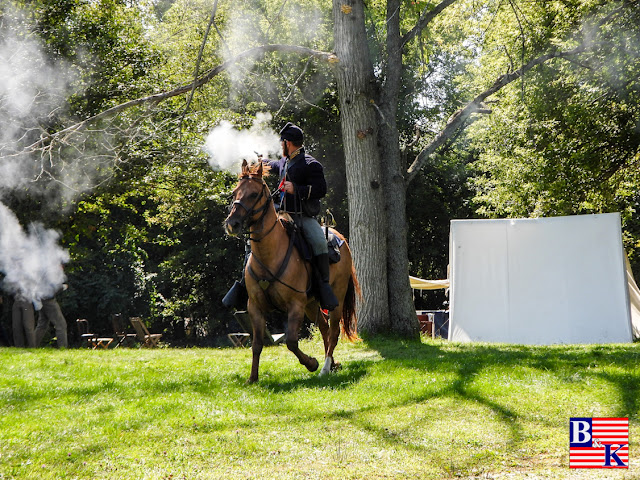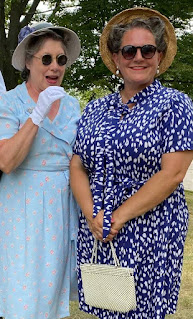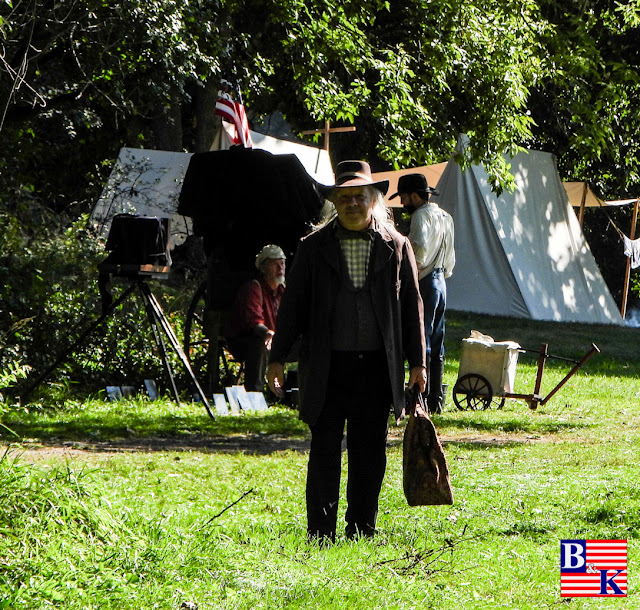The lock down for covid really did a number in the reenacting hobby, especially for the era of the American Civil War. The slowdown actually began a couple years earlier - right after the 150th activities died down - and the numbers of participants seemed to drop. Yet the number of spectators continued to be strong.
Then covid struck and the bottom dropped out.
Was it covid that convinced/scared reenactors away?
Was it that reenactors "aged out"?
Was it that younger people were not/are not interested and would rather play video games?
Was it because of the woke/cancel culture protests and too many reenactors bowing down to them out of senseless fear of being "canceled"?
Or maybe it was a bit of everything, all put into a mixing bowl...
 |
| Jackson Civil War Muster is BACK! |
Here in the Great Lake State we lost a few events during this pandemic time: Greenfield Village put their Civil War Remembrance on a "pause" (whatever that means), Detroit's Historic Fort Wayne has stopped all reenactments there as of 2022 (their last event being the ever-popular Christmas at the Fort last December), and Port Sanilac had its final "Civil War Days" in 2022 due to lack of participation from reenactors (and not due to lack of visitors, as some have claimed). It was also during this time that the previously very well attended Jackson (Michigan) Civil War Muster had also cancelled their event after over three decades. First it was moved out of its long-time Cascades Park location, which turned many people off, including spectators. Then, again, covid struck and the event was simply cancelled. Earlier this year it was rumored that Jackson would be back.
Okay...not a big deal. Just a rumor. We've heard it before.
But then we heard that not only was it truly coming back after its hiatus, but it would be back at Cascades Park!
Okay, now our ears are perked up.
Then rumor became truth - - - and interest rose...and continued to rise.
But what was going to actually happen?
All good, that's what. And we can thank Muster President Maurice Imhoff for everything. This young man worked his butt off to make it all happen. Maurice is also the founder and President of the Jackson County Michigan Historical Society as well as a long-time member of the 102nd United States Colored Troops Company B. As he stated, "The community has long wanted it back; it’s an important event to Jackson as well as the reenacting community."
Yeah...Jackson's back...
Ready to see how well it turned out?
Well, away we go!
Well, away we go!
 |
| This is the sight that greeted me Saturday morning: smoke arising from the campfires of the area known as Jacksonburg, the reenactor tent city, just like days of old. Could it look any better? |
The first thing I came upon as I moved into the "town" was the church, which only makes sense because, historically, a church was usually the first structure to be built in any new town or village. Possibly, perhaps, only a lumber mill or gristmill may had been erected before.
 |
| The church building would have also been used as a schoolhouse and a sort of town hall. Here we see Charlotte and Faith reading the latest news from the war front. |
 |
| This coffee wagon is a 7/8 size replication modeled after an 1863 original. This one was built by the Chase and Sunburn Coffee Company in 1970. |
The idea for a coffee wagon came in 1861 when delegates of the northern YMCA (Young Men's Christian Association) came up with the idea to help out with the soldier's spiritual and temporal needs of the Union Army as well as to help alleviate some of the suffering from wounds and illness.
In March of 1863, Jacob Dunton of Philadelphia built and presented to the US Christian Commission a wagon made from an artillery caisson that could brew 108 gallons of coffee, hot tea, or cocoa an hour.
No records have been found to show how many of these coffee wagons had been built, but documentation shows there was one at the Appomattox Courthouse in April of 1865.
There were many tents set up in Jacksonburg, including numerous people I did not know, so for today's posting I will concentrate on those who I do know.
 |
| Welcome to the home of Mrs. St. John (on the right). Vickie has been reenacting the Civil War longer than nearly anyone I know - and she's not very old! But she still finds such joy in this hobby. |
Next to the St. John tent was the home of Mr. and Mrs. Assenmacher: Andy & Sue.
 |
| The Assenmacher tent was filled with activity. It seemed to be the "go-to" tent. They didn't seem to mind. |
 |
| In fact, Andy was teaching his grandson how to use an axe. What an awesome skill to learn at such a young age! |
 |
| Cooking and doing dishes. All the comforts of a 19th century home. |
Next to the Assenmachers we have Jackie Schubert's 19th century home.
 |
| Patrick, and I visiting with Jackie. |
And on the far end we had the Cary tent where we see Mrs. Cary, as Mary Gardner, tell her story of what occurred on September 17, 1862, which was one of the darkest days in Pittsburgh history:
 |
| Mary Gardner, survivor of the Allegheny Arsenal explosion, speaks with the public. |
It was not considered proper for women to work outside the home, but this work was allowed because it supported the war effort.
Around 2pm, Joseph Frick was delivering wooden barrels of DuPont black powder in a horse-drawn wagon up the new stone road. Rachel Dunlap, an employee in the lab watched as Frick maneuvered his wagon into position to offload the barrels. Just then she saw a spark flash near the horse’s hooves (with iron horseshoes) and the iron-clad wagon wheels. Then she saw a sheet of flame. All it took was one tiny spark.
Many of the victims died in horrific ways. Witnesses reported bodies bursting in mid-air. A body does not survive 125,000 rounds of exploding ammunition, not to mention a couple hundred parrot-gun projectiles. Where the heat was most intense, there was nothing left but white bones in a heap.
Just as Antietam would prove the costliest day in military dead, the Arsenal explosion would produce the largest civilian death tally in the Civil War. The 34-acre complex became a grim public morgue with bodies laid out on wooden planks.
 |
| Mrs. Alto was also enjoying her time at Jackson, a-working on her sewing. |
When reenactors pose for photographs, we usually attempt to make valiant efforts to emulate the people from the 1860s and try not to smile. There are numerous reasons that people have given for the more serious poses, but the one that makes the most sense to me is early custom dictated wide-mouthed, toothy grins were considered inappropriate for portraiture. Even in other kinds of old paintings, a person's wide smiles were often associated with madness, drunkenness, or otherwise informal, immature behavior.
Now some may disagree with me, others may agree. But it was basically the custom and fashion of the times - same with the painted portraits before photography.
So...how do we get Miriam to not smile...
How about I tell her that her dog died?
I can just imagine the conversation at her (modern) home afterward:
I can just imagine the conversation at her (modern) home afterward:
"Mom, Mr. G said our dog died!"
"Dear, we don't have a dog."
"Well, not anymore!!"
 |
| I guess my little scenario didn't work! |
 |
| Mr. and Mrs. Lynch. |
 |
| Some of the loveliest of ladies are right here in this picture. Now I said "some of," for there are more lovely ladies who were not with us for this photograph. |
 |
| Susan Hansen, who can oftentimes be found with her Carrot Patch Farm woolen sutlery in the Revolutionary War period, was here in the 1860s as well. |
 |
| Dr. Mary Walker (who you know and met at Port Sanilac) had her medicine and medical supplies here at Jackson, and she kept quite busy teaching the public about medicine and health issues of the 1860s. |
 | ||
Such a wonderful mother-and-daughter picture, don't you think?
|
 |
| Dr. Trippe, another 1770s reenactor, also found himself in the midst of the 1860s Civil War, field doctor for the southern army. |
 |
A small part of military camp, which seemed to stretch on quite a ways. |
 |
The camps... |
 |
| ...the cooking... |
 |
The beauty of the sun gleaming through the branches. |
 | ||
| I visited "W.C. Badgley" the tintype photographer. I half thought of having my likeness taken, but then, I didn't want another of just me by myself.
|
I did not see the battle take place, therefore I took no pictures of it.
But Beth & Kevin from B&K Photography did. And they got some pretty nice shots.
 |
| The battle was not showing any particular historic battle but, rather, more of a tactical, showing the art of organizing and employing fighting forces in a more natural way rather than scripted. |
 |
| In other words, the military had to react to the enemy without fully knowing their plans as history shows, which made it actually more interesting, from what I was told. |
 |
| As you can partially see in this phot, there was a good amount of spectators who showed. |
 |
| The cavalry is always my favorite part of any battle. I must admit, I've longed to see someone on a horse "take a hit." I know...it's dangerous...but just imagine...  |
 | ||
| Though some folks have condemned battle reenactments due to the violence and what some have deemed the "glorification of war," I - and the greater majority of people - enjoy the history of it...seeing and hearing what it was like, even to a small extent. the sound of musketry and cannonading brings this time in our history to life for all those interested. So I tell those people who do not like it to be on their way.
|
 | ||
| We often see the outcome of original pictures like this, but, because we weren't there, we do not see the set up beforehand, so I would imagine it would not had been too different from what we see here. And below is the color version of what the tintype will look like. Unfortunately, I have not seen how this particular tintype turned out.
|
 |
| Here is Larissa and friend, Cyndi. Friends in the 1860s. Both ladies also reenact the 18th century as well. |
 |
| Here is Cyndi and Larissa, friends in the 1940s. Larissa is the chaperone for the girls on the baseball team. |
In 1943, with so many men off fighting overseas, Philip K. Wrigley founded the All-American Girls Professional Baseball League. To find players for a women’s league, Wrigley sent scouts out across the United States, Canada and Cuba. A total of 60 women made the cut for the first 1943 season, and were divided among four teams: the South Bend Blue Sox, based in Indiana; the Rockford Peaches, based in Illinois; and the Kenosha Comets and the Racine Belles, both based in Wisconsin. Over 600 women played in the league, which eventually consisted of 10 teams located in the American Midwest. The league actually continued after our boys were brought home once they won the War: in 1948, league attendance peaked at over 900,000 spectators!
Larissa portrays a chaperone for the girls. Chaperones were assigned to each team and acted as "surrogate mothers" to the players. They traveled with the team and were responsible for making hotel reservations, disbursing payroll and meal allowances, laundry, social engagements, and enforcing curfews.
 |
| Rebecca and Jillian both showed up on Sunday. Unfortunately, I was not there to see them, but I am glad Jackie was able to catch a photo. All four here also reenact WWII, with Beckie & Jill playing on the All-American Girls Professional Baseball League of 1943 at the reenactments. |
So, as you can see, Jackson 2022 was a rousing success...and I feel it will find its way back to where it once was. Next year will be the true tell-all of it.
As Maurice Imhoff mentioned on WXYZ TV News in Detroit:
"...it’s an important event to have back so people can learn America’s history.
“We want to be able to learn, let’s go back in time, let’s look back at the history of where we were divided at one point in time, and how did we rebuild?” he said. “What were some of the discussions going on here? You can come ask the re-enactors why this happened. How can we rebuild, in many cases, including the confederate flag. It’s banned from many events and such, but this is the location where we want to talk about in a historical event.”
And he told me, "Seeing the smiles and laughs all weekend long told me all the work and raising the funds… was most certainly worth it!
It’s important to study our history, especially in a time of such division. We intend to evolve our program and encourage open discussion to bring greater awareness of the relevancy of the events of the Civil War and its immediate aftermath to today's people. It is our hope these efforts will promote healing and equality for all."
So...was it the Jackson of 10-12 years ago?
Not quite. But give it some time...and as long as you, the reenactor, will continue to put in a little effort to show up, the Jackson of 10-12 years ago may just return.
Not quite. But give it some time...and as long as you, the reenactor, will continue to put in a little effort to show up, the Jackson of 10-12 years ago may just return.
But in the meantime...for 2022, Jackson's back...!
Until next time, see you in time.
B&K Photography (Beth & Kevin)
Larissa Fleishman
Jennifer Mailley
Miranda Davies
Jackie Schubert
Rebecca Goodenow
and, yes, a number of those here are also from me!
~ ~ ~













No comments:
Post a Comment